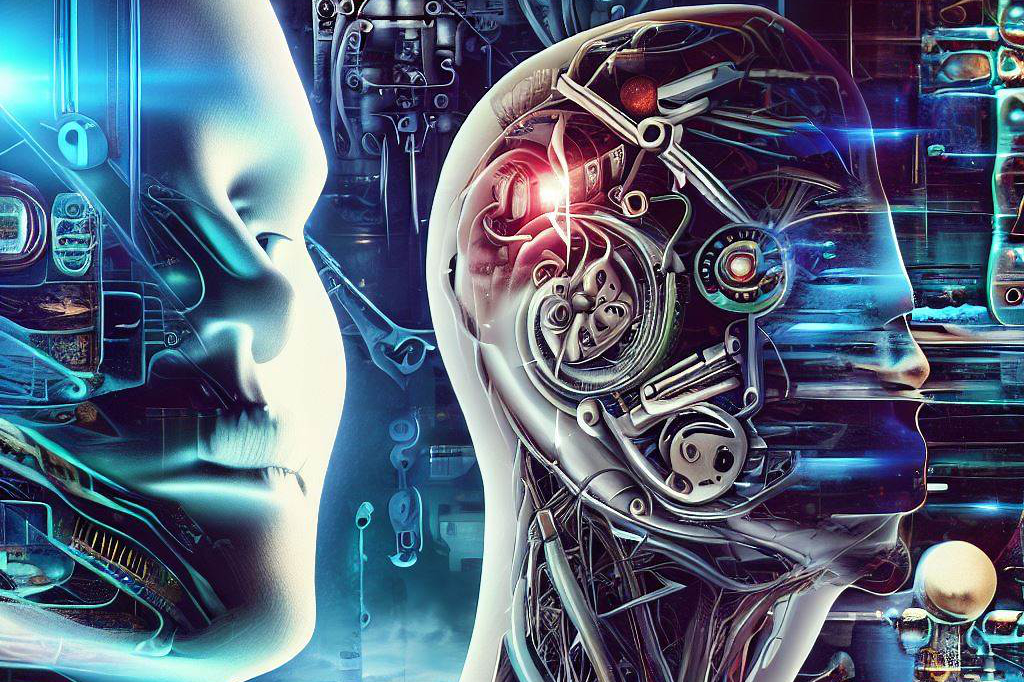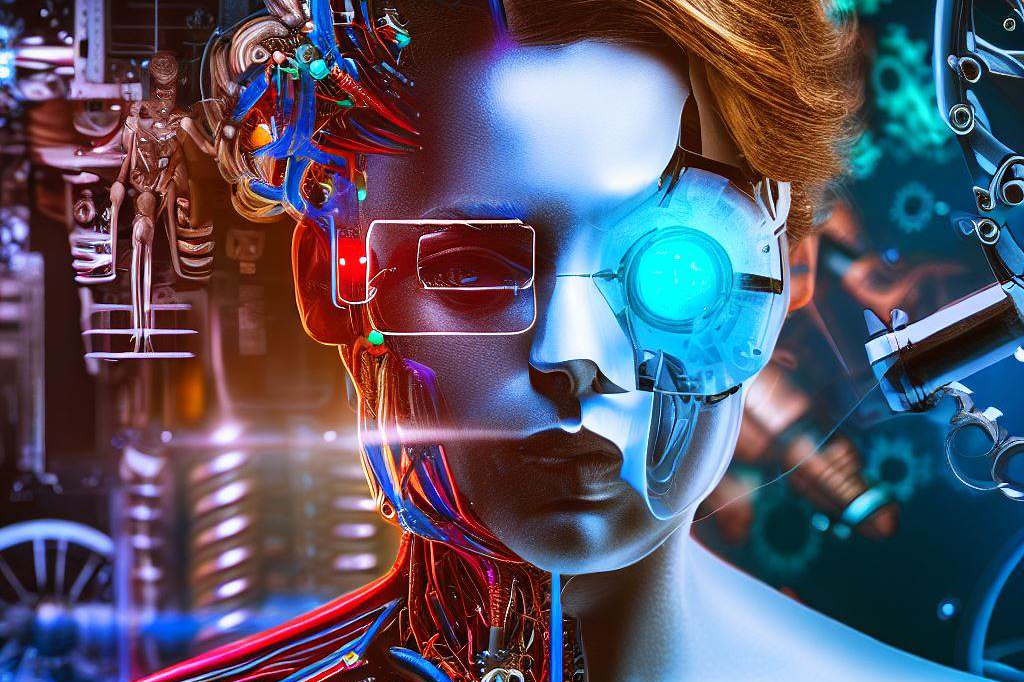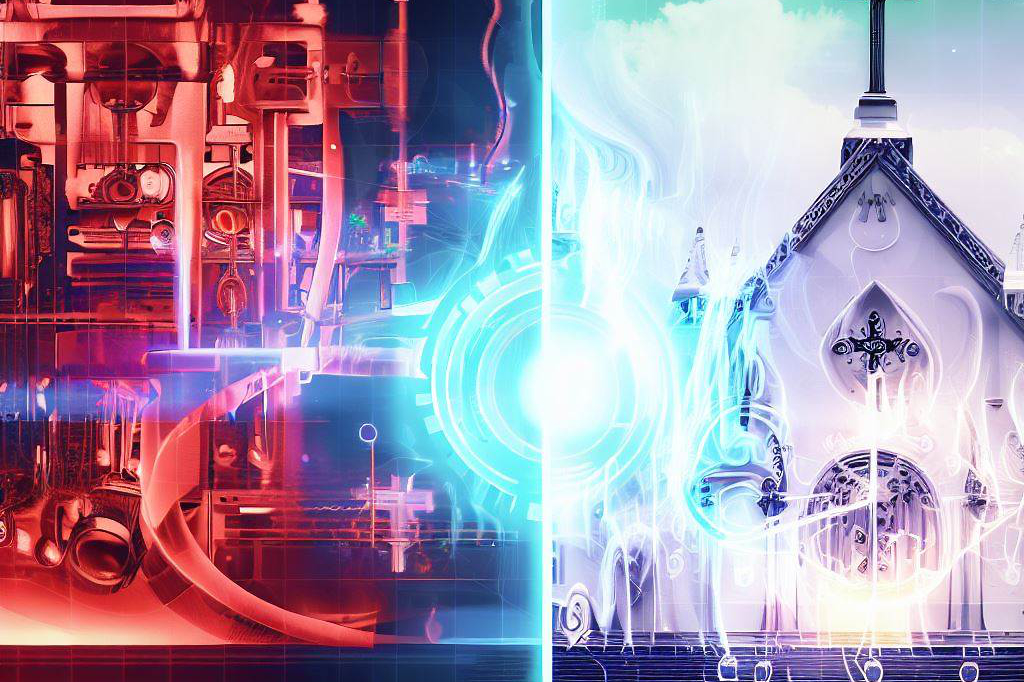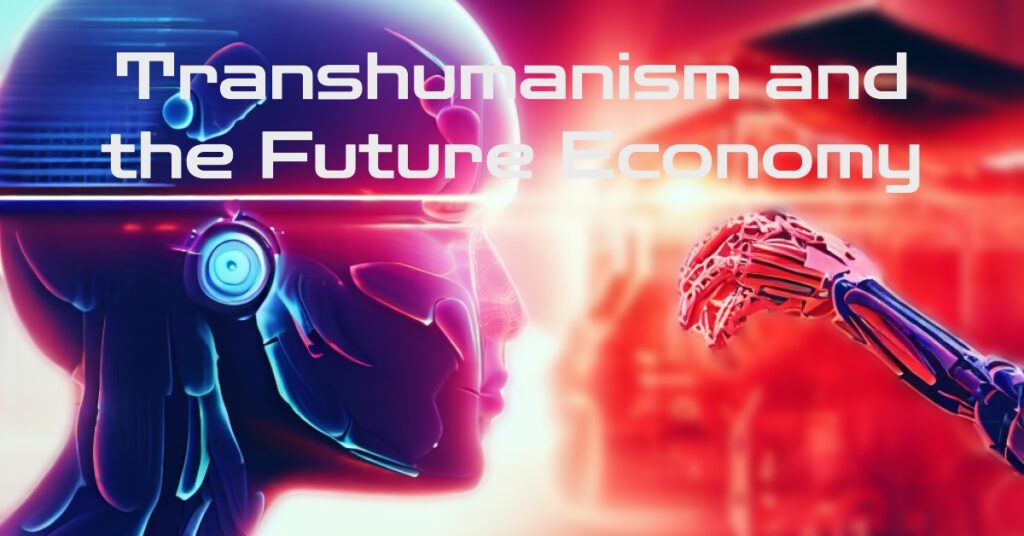Transhumanism is a philosophical and cultural movement that advocates for the use of technology to enhance human capabilities beyond what is considered natural or normal. This includes the use of
- genetic engineering,
- cybernetic implants,
- and other advanced technologies
to augment human physical and mental abilities.
Transhumanists believe that by transcending our biological limitations, we can achieve a new level of existence and overcome many of the problems that plague humanity.
Religion, on the other hand, is a set of beliefs and practices that seek to understand the nature of existence and our place in the universe. It typically involves worshiping one or more deities or spiritual forces and following a set of moral codes or commandments.
For many people, religion provides a sense of purpose, meaning, and community. The intersection of transhumanism and religion is an increasingly important topic as advances in technology continue to push the boundaries of what it means to be human.
Some religious leaders have welcomed these technological advancements as a way to alleviate suffering and improve the human condition. Others view them as a threat to traditional religious beliefs about human nature and morality.
Definition of Transhumanism

Transhumanism is often described as a cultural movement or philosophy that seeks to transform humanity through technology. Its core belief is that we can enhance our physical, mental, and emotional abilities beyond what is considered natural or normal through scientific methods such as genetic engineering, cybernetic implants, nanotechnology, biotechnology, and neurotechnology.
Transhumanists argue that by using these technologies to overcome our biological limitations – such as aging or disease – we can achieve greater levels of health, longevity,and intelligence than would be possible otherwise.They also see transhumanism as an opportunity for humans to evolve into post-human beings with vastly superior abilities – essentially becoming something new altogether.
Overview of Religion and Its Traditional Beliefs

Religion is a complex and multifaceted phenomenon that takes many different forms across cultures and societies. At its core, religion involves a belief in one or more higher powers or spiritual forces that govern the universe.
It also often includes a set of moral codes and practices that guide human conduct and behavior. Many religions have traditionally held beliefs about the limitations and nature of humanity.
For example, Christianity teaches that humans are created in the image of God but are fallen beings due to original sin. Islam teaches that humans are God’s most noble creation but are inherently flawed due to their tendency towards sinfulness.
The Intersection of Transhumanism and Religion

The intersection between transhumanism and religion is complex and multifaceted. On one hand, some religious leaders see technology as a way to alleviate suffering and improve human health – goals that align with many transhumanist aims.On the other hand, transhumanism challenges traditional religious beliefs about human nature, mortality, immortality, soul,and salvation.
For example, some Christians worry that transhumanism represents an attempt by humanity to play God – an act explicitly forbidden by scripture. Others have raised concerns about the implications of advanced technologies for concepts such as free will or the soul.
Overall, there is much debate around whether transhumanist aims are compatible with traditional religious beliefs.Depending on who you ask,the answer might be yes, no, or somewhere in-between.In any case, it seems clear that this intersection represents an important topic for discussion, collaboration, and debate going forward.
Transhumanism: A Quest for Human Enhancement

The Goals and Aspirations of Transhumanists
The primary goal of transhumanists is to use technology to improve the human condition in all possible ways. This includes enhancing our physical abilities beyond what nature has provided us with through genetics or evolution.
Transhumanists believe that humanity can transcend its current limitations if we harness science and technology in the right way. For example, some transhumanists aim for immortality by creating technologies that can preserve consciousness after death or by developing new medical treatments that could cure previously fatal diseases.
Others aspire to achieving superintelligence through AI or expanding human senses beyond their natural limits with cybernetic implants. Ultimately, the overarching goal of transhumanism is to create a post-human civilization where humans have control over their own evolution and can continuously improve themselves indefinitely.
The technologies and methods used for human enhancement
Transhumanists employ a wide range of technologies and methods to achieve their goals. One of the most promising fields for transhumanism is biotechnology, which involves using genetic engineering and genomic editing to create new abilities or enhance existing ones.
Another promising field is nanotechnology, which involves manipulating matter at the molecular level, enabling us to create materials with properties beyond what we find in nature. Nanotechnology can also be used to create implants that enhance cognitive abilities or repair damaged tissues.
AI and robotics are also essential to achieving the transhumanist vision. AI can help us analyze complex data sets and make predictions about future events.
Robotics can enable physical enhancements by creating prosthetic limbs that operate like natural limbs or exoskeletons that augment human strength. Transhumanism is a movement dedicated to using technology to advance human capabilities beyond our current biological limitations.
The history of transhumanism dates back centuries, but it has gained popularity as a formal movement in recent decades. Transhumanists believe that through technological advancements such as biotechnology, nanotechnology, AI, and robotics, they can achieve a post-human civilization where humans have control over their own evolution and continuously improve themselves indefinitely.
Religion: Traditional Beliefs on Human Nature and Limitations

Overview of major religions’ beliefs on human nature
The world’s major religions have differing views on human nature.
Christianity, for example, views humans as created in the image of God and endowed with a moral sense that sets them apart from other animals.
Islam sees humans as Allah’s most significant creation, with the potential to attain spiritual heights through submission to Allah’s will.
In Hinduism, humans are seen as evolving through many incarnations towards ultimate unity with Brahman, the infinite and eternal reality underlying all existence.
Buddhism teaches that humans are not separate entities but rather interconnected parts of a greater whole.
Jainism believes that humans can achieve spiritual enlightenment by overcoming their attachment to material things.
Across various religious traditions, there is an understanding that humans possess unique qualities or characteristics that distinguish them from other life forms.
Traditional views on the limitations of human beings
Most religious beliefs acknowledge human limitations such as physical weakness, ignorance, and mortality.
In Christianity, for example, humanity is viewed as fallen and in need of salvation because of its inherent sinfulness.
In Buddhism and Hinduism, it is understood that suffering arises from ignorance and attachment to material things.
In Judaism and Islam, one finds a belief in the ultimate judgment after death, when one will be held accountable for actions performed during life.
These beliefs serve to remind us that we are not all-powerful beings but rather mortal creatures limited by our physical bodies and worldly circumstances.
The role of faith in accepting human limitations
Faith plays a vital role in helping people come to terms with their limitations as human beings. For many believers across different religions, such as Christianity or Judaism, faith helps them find meaning in life despite its challenges or obstacles.
For example, Christian teaching offers assurance that God’s love for humanity transcends death, providing hope for a life beyond this world. Similarly, the concept of karma in Hinduism and Buddhism offers a framework for understanding the interconnectedness of all things and a path towards enlightenment.
In Islam, submission to Allah’s will provides believers with comfort in times of difficulty or suffering.
Faith can help people accept their limitations by offering reassurance that there is meaning and purpose to our existence beyond what we can comprehend or control on our own.
Challenges to Traditional Religious Beliefs by Transhumanism
Transhumanism’s goals and aspirations for human enhancement pose a challenge to traditional religious beliefs. Transhumanists aim to enhance human abilities and overcome the limitations of the human body, including death.
However, many religious traditions view the human body as a sacred vessel created by divine power and hold that death is a necessary part of the natural order. Furthermore, transhumanist aspirations such as immortality and resurrection conflict with traditional religious views on life after death.
For example, some Christian denominations believe in the resurrection of the body, in which God restores physical bodies to their original form at the end of time. The idea of enhancing or replacing those bodies with technological advancements is seen as incompatible with this belief.
The conflict between transhumanist goals and religious beliefs on the nature of humanity
Transhumanists argue that technology can be used to transcend human limitations and create new forms of existence that are superior to what is currently possible for humans. This view clashes with traditional religious beliefs about the nature of humanity, which often posit humans as created beings with inherent limitations designed by divine powers.
For instance, Christianity teaches that humans are created in God’s image but are also flawed due to original sin. While some Christians may see transhumanism’s quest for self-improvement through technology as an expression of God-given creativity and intelligence, others may view it as an attempt to play God or usurp divine authority.
The implications for religious concepts such as the soul, immortality, and resurrection
The potential implications of transhumanism for concepts such as the soul, immortality, and resurrection are significant. For example, some proponents argue that consciousness can be replicated through digital means or transferred into new bodies beyond our biological form. This view raises questions about what happens to individual souls after death if consciousness can be preserved or transferred.
Moreover, if transhumanist goals are achieved in the realm of immortality, how does this impact religious beliefs about the afterlife? Do concepts like heaven and hell become obsolete if humans can live indefinitely in their current form?
Religious Responses to the challenges posed by Transhumanism
The relationship between religion and transhumanism is complex and multifaceted. Some religious groups embrace the possibilities of technology, while others reject it outright. Religious responses to transhumanism range from cautious optimism to outright condemnation.
For instance, some Christian theologians have been critical of transhumanism’s focus on individual enhancement over communal well-being, arguing that it could lead to a society that values certain individuals over others. Others have seen an opportunity for collaboration between religious leaders and transhumanists on ethical issues related to human enhancement.
While there are significant challenges posed by transhumanism to traditional religious beliefs, there is also potential for finding common ground. Open dialogue between proponents of both movements is crucial for navigating these complex issues and ensuring that technological progress is balanced with ethical considerations.
Finding Common Ground Between Transhumanism and Religion

The importance of dialogue between proponents of both movements
The intersection between transhumanism and religion creates a complex and challenging discussion. It is, however, important to emphasize the need for dialogue between the proponents of both movements. The transhumanist community has been criticized for not taking ethical and moral considerations into account while pursuing their goals.
On the other hand, religious communities need to recognize that human enhancement technologies are continuously advancing, and it is essential to engage in conversations with those who advocate for technological progress. A productive dialogue would involve an exchange of ideas on how to move forward without compromising one’s beliefs or values.
Both groups have much to contribute to the conversation, particularly on matters concerning morality, ethics, and social responsibility. Therefore, it is crucial that these discussions take place in an atmosphere of mutual respect.
Potential areas for collaboration between transhumanists and religious communities
There are potential areas where both transhumanists and religious communities can collaborate. An area where collaboration could be fruitful is medicine.
Working together on medical research and development projects that aim to improve human health conditions while respecting the ethical concerns inherent in these studies could benefit both groups. Another area where collaboration could be pursued is education.
There can be a joint effort by religious leaders/scholars/philosophers together with leading experts from various disciplines within the transhumanist movement (such as AI or robotics), to develop curriculums covering topics related to ethics in technology development. There could be collaborative efforts around specific issues, such as climate change or poverty alleviation, where mutual interests may converge.
The need to balance technological progress with ethical considerations

Transhumanism believes that technology can solve many problems facing humanity today. However, it is essential not only to develop technology but also to consider ethical implications.
The need to balance technological progress with ethical considerations is of paramount importance. Religious communities can provide valuable contributions to ethical and moral deliberations surrounding technological advancements.
On the other hand, transhumanists can help religious communities appreciate the potential benefits of innovative technologies. Transhumanism and religion represent two different paradigms that are constantly evolving.
Their intersection raises contentious issues but also offers opportunities for mutual learning and collaboration. By engaging in open-minded dialogue, both parties can work together to achieve a better understanding of each other’s perspectives while seeking common ground on how to move forward cautiously yet ambitiously towards a future that benefits all humanity with respect for our shared values.

C M, a seasoned editor, journalist, and consultant, is deeply fascinated by the convergence of technology, space, and the future of humanity.
With a particular interest in transhumanism, futurology, and the philosophical and ethical dimensions of these domains, C M serves as the lead contributor to TranscendSphere and SpaceSpotlight.
When not penning insightful articles on these rapidly evolving fields, C M indulges in their love for podcasts and books, proudly embracing their status as a ‘Happy Nerd Extraordinaire!’





